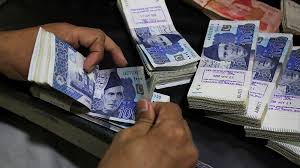On Tuesday, the government revealed a borrowing plan requiring Rs32 trillion for the fiscal year 2024-25, which includes rollovers from foreign banks and bilateral lenders. The plan’s success depends on the prompt approval of the International Monetary Fund (IMF) programme and continued financial backing from China.
The Ministry of Finance’s annual borrowing plan details Pakistan’s strategy to meet its Gross Financing Needs (GFN), which cover both the budget deficit and maturing debts. The plan specifies that Rs8.5 trillion will be needed to address the budget deficit, with an additional Rs23.4 trillion required for debt repayments.
This Rs32 trillion borrowing requirement does not account for the Rs2.6 trillion needed by the State Bank of Pakistan (SBP) to meet its obligations, including $3.7 billion owed to the United Arab Emirates, $4.2 billion in Chinese trade finance, and $900 million in maturing IMF debt.
Successive governments have relied on rolling over maturing debt, which has increased interest payments and contributed to the rise in gross financing needs. For the 2024-25 fiscal year, the estimated gross financing needs of Rs32 trillion represent 26% of GDP, excluding central bank obligations. This is considered unmanageable for a country like Pakistan, where financing needs exceeding 15% of GDP are problematic.
The borrowing plan’s success hinges on timely IMF approval and China’s agreement to roll over nearly $7.9 billion in debt, including $4 billion in cash deposits and $3.9 billion in foreign commercial loans. Finance Minister Muhammad Aurangzeb had anticipated IMF approval of Pakistan’s $7 billion bailout package by the end of August, but the IMF’s schedule does not yet include Pakistan, raising concerns about the minister’s assurances.
The plan indicates that Rs8.5 trillion will be allocated for budget deficit financing, with 92% expected to come from domestic sources and only 8% from foreign loans, a decrease from the historical 20% provided by foreign lenders.
Securing timely rollovers of foreign loans is a major challenge, particularly as the government seeks to rebuild its economic relationship with China. Beijing has provided $4 billion in cash deposits, $3.9 billion in foreign commercial loans, and $4.2 billion in trade finance facilities, all maturing this fiscal year. The government also plans to refinance $3.9 billion in foreign commercial bank loans and raise an additional $1.2 billion in new commercial debt, though progress has been slow due to high costs.
The government intends to roll over $4 billion in bilateral deposits from China and $5 billion from Saudi Arabia, but UAE debt, listed on the central bank’s balance sheet, was not mentioned. Additionally, the government aims to raise around $1 billion through Panda Bonds in China and Green Bonds in international markets. The issuance plans include a $300 million Panda Bond and a $700 million global green bond.
The finance ministry also plans to secure $800 million in budget support loans from the Asian Development Bank (ADB), including $400 million for a Climate and Disaster Resilience Enhancement Programme, $100 million for Women Inclusive Finance, and $300 million for Domestic Resource Mobilisation.
The Debt Office has cautioned that the Rs32 trillion borrowing plan is subject to changes due to domestic and international economic conditions and debt market dynamics. To manage floating rate debt exposure, the government plans zero net issuance of treasury bills this fiscal year and will focus on refinancing maturing loans through long-term securities like Pakistan Investment Bonds and Government Ijara Sukuk, aiming to increase the issuance of fixed-rate debt securities.




